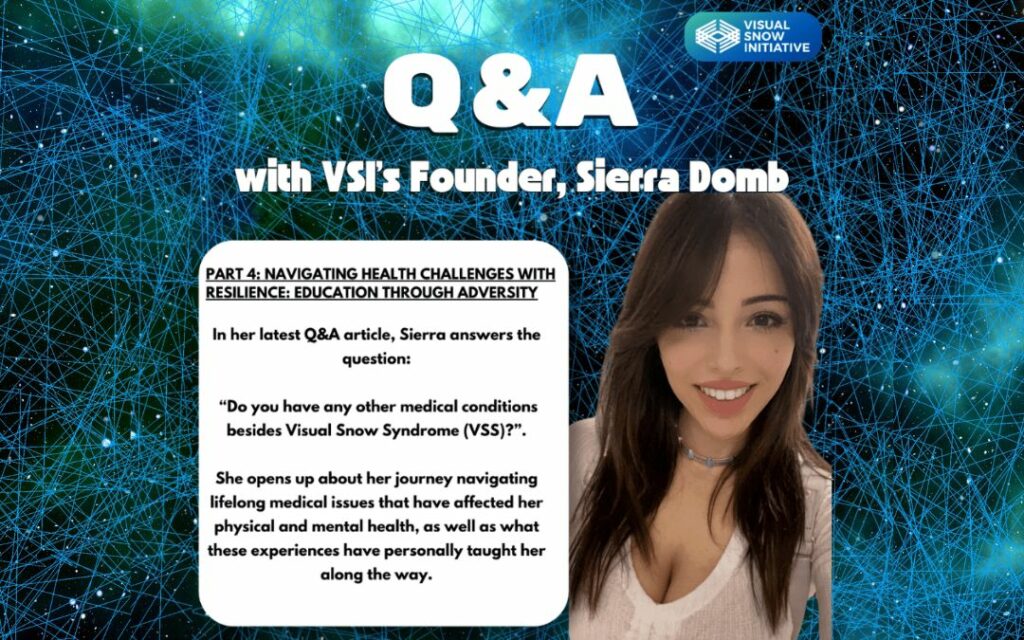Sierra Domb Q&A - Part 4
Navigating Health Challenges with Resilience: Education Through Adversity
by Sierra Domb, Founder & CEO, Visual Snow Initiative

Important Note
Please note that this Q&A is from 2024. The information provided may have been updated in accordance with VSI’s progress, Sierra’s work, personal experiences, and feelings, as well as scientific advancements and other developments. As such, some details may be outdated. For the most current information, please refer to VSI’s official resources.
Introduction and A Heartfelt Thank You
Hello, and thank you to everyone who took the time to participate in my Q&A.
I sincerely appreciate the thoughtful questions and personal experiences that were shared regarding Visual Snow Syndrome (VSS). The Visual Snow Initiative (VSI) team and I value your kind words and your efforts to bring attention to this important topic.
Due to the high volume of submissions, I have grouped similar questions together to provide responses that may be helpful to as many individuals as possible.
To keep the information clear and accessible, the Q&A will be shared across several articles, with related topics organized together.
If your question is not directly addressed, I kindly encourage you to explore the resources linked below, which likely already contain the information you are looking for.
Thank you in advance for your understanding.
Visual Snow Syndrome (VSS) and the Visual Snow Initiative (VSI): Helpful Answers and Resources for Common Questions
After reviewing the questions submitted for my Q&A, I would like to share the following links. These resources specifically address many of the inquiries and provide detailed information.
Visual Snow Syndrome FAQ
Many of the submitted questions are addressed on our FAQ page, which provides answers to common inquiries about VSS and VSI, along with helpful resources and linked information.
Visual Snow Syndrome Misconceptions
Our VSS Misconceptions page offers educational content that clarifies and corrects several of the most prevalent misconceptions about the condition.
The Essentials of Visual Snow Syndrome
Our About Visual Snow page provides an overview of Visual Snow Syndrome, including its impact, causes, symptoms, history, and more, along with links to additional resources and visual guides.
Science-Based Treatment Options & Management Strategies for Visual Snow Syndrome
For inquiries about available treatment options and management strategies for VSS, please refer to the Treating Visual Snow page on the VSI website, which outlines evidence-based approaches for symptom management.
Visual Snow Syndrome News & Research (Latest Updates)
The Visual Snow Initiative’s Visual Snow Syndrome Research
VSI has supported many research studies exploring different aspects of VSS, including biomarkers, pathophysiology, and potential treatment options (both noninvasive and pharmacological). These studies have aimed to enhance our understanding of VSS and explore new treatment possibilities, contributing to the long-term goal of finding a cure. For details on studies, updates, and a list of research initiatives supported by VSI, please refer to the links above.
Finding a Doctor with Knowledge of Visual Snow Syndrome
For individuals struggling to find a physician with knowledge of VSS in their area, please refer to our Global Physicians Directory, where you can search for doctors or specialists by location.
Note: If there is no doctor in your area who is familiar with VSS, you can share the official Diagnostic Criteria and the resources available on the VSI website, which may assist in diagnosis and help them better understand the condition.
Neuro-Optometric Rehabilitation Therapy (NORT) Practitioners for Visual Snow Syndrome
For those seeking a list of providers with knowledge of both NORT and VSS, this information is available on our Treating Visual Snow > NORT page.
Mindfulness-Based Cognitive Therapy (MBCT) for Visual Snow Syndrome: Global Access and Research
The Visual Snow Initiative partnered with Oxford Mindfulness to help make Mindfulness-Based Cognitive Therapy (MBCT) more accessible worldwide for individuals interested in exploring it as an option for Visual Snow Syndrome. To learn more about this collaboration and ongoing MBCT research, visit our Treating Visual Snow > MBCT page.
Medications and Visual Snow Syndrome: Pharmacological Considerations
This page offers educational information about medications and their reported effects, if any, on Visual Snow Syndrome, drawing from both research and anecdotal accounts. It is intended for informational purposes only. For personalized care, please consult a qualified medical professional who can guide you based on your symptoms, medical history, and individual needs.
Visual Snow Syndrome Patient Guide
If you are new to Visual Snow Syndrome and seeking guidance on how to proceed, in addition to consulting a qualified medical professional, our VSS Patient Guide can help walk you through the process. It presents information in a concise way to help you better understand your condition, options, and available resources.
VSI 4 Kids
For children or parents of children with Visual Snow Syndrome, VSI has developed the first-ever pediatric resource for the condition, called VSI 4 Kids.
Additionally, the Visual Snow Initiative website offers further comprehensive information and resources on Visual Snow Syndrome (VSS), including a detailed timeline of key events related to VSS, statistical data and demographic insights, ICD-11 codes for both Visual Snow Syndrome (the condition) and Visual Snow (the symptom), a VSS simulator (desktop only), the first VSS video support group in partnership with the AnCan Foundation, and more.
Q&A Portion: Insights and Responses
Q: Do you have any other medical conditions besides VSS?
As a child, I was diagnosed with Autoimmune Dysregulation. I have also had Erythromelalgia since childhood but was formally diagnosed with it in young adulthood. The two are interlinked. Although my Erythromelalgia never improved, early treatments with corticosteroids offered temporary relief for some of my autoimmune issues. Unfortunately, I developed Cushing’s Syndrome as a side effect of the corticosteroids, which caused significant physical changes and continued discomfort. My body was noticeably swollen, bright red, and in pain. Facing bullying and harassment regarding my appearance, I tried explaining that I was battling medical issues in the hopes that the individuals would stop. Some eased up while others intensified their behavior. Finding limited empathy, I decided to keep my struggles private as I grappled with my health issues and societal reactions to my appearance.
During this time, I couldn’t grasp why people were so cruel and judgmental. I yearned to be “normal,” free from my medical issues, which I thought would solve everything. Juggling school, homework, extracurriculars, and managing my health was overwhelming. I struggled to keep up academically and socially. Additionally, many doctors expressed surprise at my condition, remarking that I was “too young” to face such health issues. This reaction, though not based on scientific reasoning, deepened my sense of feeling like a misunderstood anomaly.
The mix of physical pain and emotional stress took a toll on my mental health, leading to anxiety and depression. The unwavering support of my amazing family and friends was crucial during this time. Opening up to them showed me that there are people capable of empathy, kindness, and understanding. I soon found a physician, who embodied professionalism, scientific knowledge, and benevolence, to help me navigate my health challenges more effectively. After stopping corticosteroid treatments, my Cushing’s Syndrome resolved, and some autoimmune symptoms became less severe, though I continued to struggle with persistent Erythromelalgia. In 2015, I experienced the sudden onset of Visual Snow Syndrome (VSS), which added a new and extremely complex layer to my ongoing health journey. I developed Post Traumatic Stress Disorder (PTSD) after my harrowing experience with VSS.
Although I experienced temporary relief in my youth following intense corticosteroid therapy, which comes with risks and side effects, Autoimmune Dysregulation and Erythromelalgia continue to affect me and flare up due to various factors such as viral illness, stress, and more. The unpredictable nature of these conditions, where symptoms can fluctuate from better one day to worse the next, often leads to physical pain, immunocompromisation, frustration, and a significant toll on mental health. This has been further compounded by the onset of VSS and the PTSD that followed my medical journey with it. Some symptoms overlap between VSS and my other health conditions, so their severity can be influenced by multiple factors.
My Visual Snow Syndrome Journey:
TEDx Talk – What Is Visual Snow? Transforming Anguish into Action
Backstory – How/Why I Founded Visual Snow Initiative
My experiences taught me profound lessons about the unpredictability of life and the challenge of fitting into societal molds of “normalcy” and health, especially as a young person. Facing bullying and judgment, I learned a critical truth: going out of one’s way to make unsolicited cruel remarks or harmful assumptions rooted in superficiality, personal biases, and stereotypes, says far more about the person making the remarks than the person they are targeted at. Whether the person is aware of it or not, their compulsion to disparage others is a projection of linear thinking, close-mindedness, ego, insecurities, ignorance, prejudices, and personal opinions. They are not rooted in fact, objectivity, or science; they merely reflect the personal beliefs and biases of the beholder, not the truth of who we are. This realization empowered me to define my self-worth not by physical conditions or societal perceptions, but by the strength of my character and my actions.
My life may have been “easier” without medical issues. But I ultimately accepted the only body I have and chose to make the most of life despite any limitations. Although they may have made me a bit more cynical, these experiences exposed me to the realities of life from a young age. I personally do not believe everything happens for a reason, but I do believe that if you so wish, you can learn and gain insights from everything that happens to you. Recognizing that adversity, both physical and emotional, are inevitable in life, especially with chronic conditions, I have learned the importance of resilience and being kind to oneself. If life knocks me down, I may feel temporarily defeated, which is completely okay and understandable. During difficult times, if life allows, I will try to prioritize my well-being and do whatever else I need to cope. But ultimately, after getting knocked down, I always choose to get back up. I realize that my circumstances will certainly never change unless I try to change them. It is possible I may try and fail, but I also might succeed. However, failure is guaranteed if I do not try at all.
Taking action may not only resolve or improve my problems but it may also help others and catalyze widespread positive reforms. This mindset enables me to rise above adversity and turn pain into being proactive. While I cannot control unpredictable challenges that arise, I can control my perspective and response to them. This mindset of resilience and proactive action fuels my passion to empower others and advocate for systemic improvements in healthcare. My journey has deeply motivated me to champion education and positive reforms in physical and mental health.
Additional Answers to Questions
In addition to the resources shared in this article and my other Q&A articles, the Visual Snow Initiative YouTube channel features the VSS News Video Series and The Cure of Understanding Video Series, where our team of VSS experts address a wide range of questions related to Visual Snow Syndrome and the Visual Snow Initiative.
For any further inquiries, please visit our Contact page.
You can also access my latest Q&A articles and more information at www.sierradomb.com.
Thank you again to everyone who submitted their questions and participated in my Q&A.
– Sierra Domb

